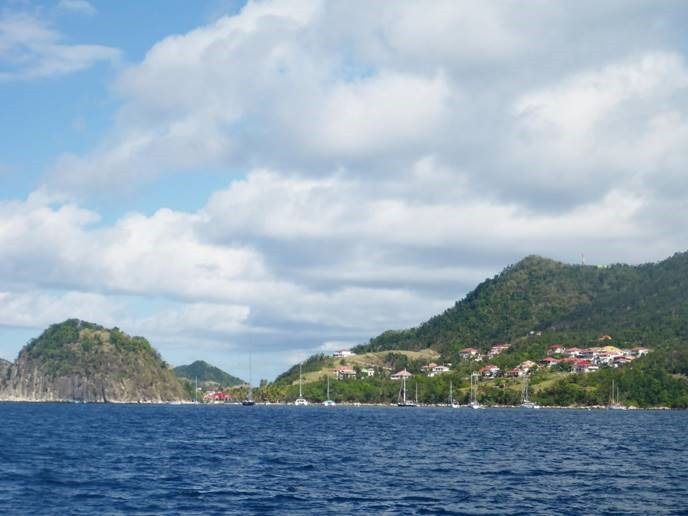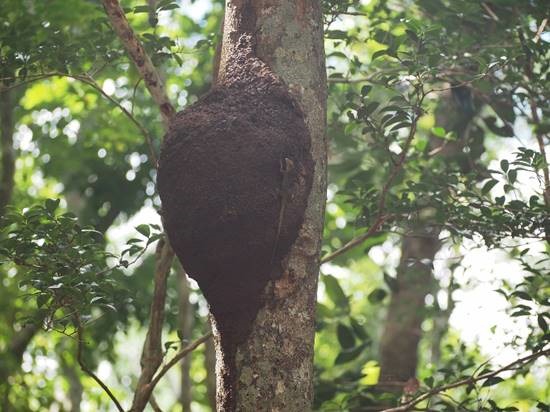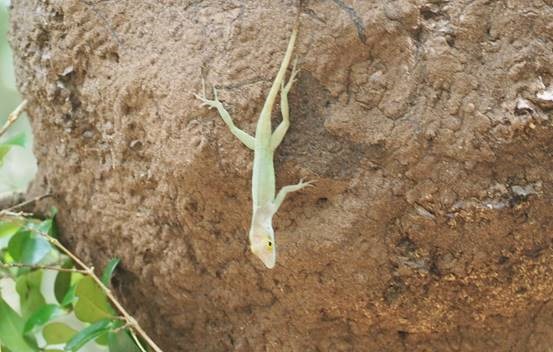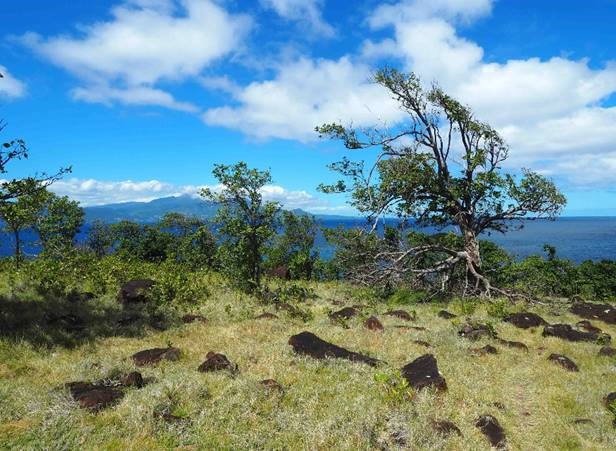3 March - Les Iles des Saintes

|
15:51N 061:37.3W In terms of sightseeing, there was not a great deal more that we could have done in Dominica, apart from tour disaster sites. But as we sailed away from that beautiful island, all kinds of reasons to stay popped into my head. Who were the key people to talk to on the island? What, if anything, might they want out of a relationship with Portsmouth, UK? What relief efforts were actually in place and delivering results – and how might something on a relatively small scale fit in? We left without answers to any of those and will need to graft away using spasmodic internet connections to get some traction. The passage to Les Iles des Saintes, off the southern end of Guadeloupe, was one of the easiest since we arrived in the Caribbean. With 15 to 20 knots of wind on the beam, a low easterly swell, great visibility and not a rain shower in sight, this was Caribbean sailing at its best.
The main island of Iles des Saintes, with the Pain du Sucre on the left It’s only twenty miles across the Guadeloupe Passage from Dominica to this group of four small islands (presumably the tip of an old volcano) but the differences were immediately obvious. First off, you can have any colour of roof you like, so long as it’s red. Secondly, everyone actually has a roof – I think we saw one house on Terre-de-Haut with a tarpaulin, but it might not have been a hurricane-related repair. We were definitely back in France and it was quite crowded. The islands are very picturesque and as we arrived around teatime, there were two cruise ships at anchor where it says ‘anchoring prohibited’ on my charts. I got the usual French ‘you can’t pick up that buoy’ welcome from someone dressed as the harbour master. There was plenty of room to anchor though, in about 10m of water, just to the east of a fine lump of rock aptly named the ‘Pain de Sucre’. These islands are relatively unusual in history as they were not used for sugar or spice production, so no slaves were ever introduced. The current inhabitants are descended from people who came voluntarily. Although Admiral Rodney defeated the French at the Battles of Les Saintes, I don’t think they were ever under British rule. Admiral Rodney has popped up on this deployment more than once: he played a key role in the lifting of the siege of Gibraltar, captured Grenada and Dominica from the French and generally left his calling card all over the place. His protegee, Lord Howe followed pretty much in his footsteps – as well as having spookily close links with some islands in the Tasman Sea and the city of Nottingham.
Les Iles des Saintes, from Terre-de-Bas We set off ashore to complete customs formalities, but on the way in ran into our friends Andrew and Kate aboard WILDSIDE. One beer is never quite enough, so by the time we got ashore it was well after 8pm and we did not hold out much hope of hauling down our Q Flag that night. But in the French islands, customs clearance is no longer carried out by uniformed personnel with huge foolscap ledgers and blotchy biros; instead you sit at a computer, fill out a ‘select from the following options’ website and guess what the answers are in French! We paid a couple of Euros to the café owner for the privilege (he signs the printed form and that’s it…). The main village on Terre-de-Haut is brazenly oriented towards tourism and was quite lively even though the cruise ships had departed. As all the buildings are concrete, there were no signs of hurricane damage and the overhead cables were in good order (as far as I could tell in the dark!). The place was a cross between Polperro and Salcombe, although the overall atmosphere was uniquely Franco-Caribbean. Once again, people of African descent were in the minority. We ate upmarket burgers and a poor imitation of a crème brulée at Paris prices and returned onboard under a beautiful full moon. We could see starfish on the seabed in 10m of water at midnight. Extraordinaire! Overnight, the wind shifted more into the north east and by morning we were rolling around a fair bit. One the way into the bay we had noted a couple of other possible anchorages so we got underway and went to find somewhere a bit quieter. Half an hour later we dropped anchor in a picture-perfect bay on the south side of Terre-de-Bas where there were only two or three other yachts. Not much of a beach at the top of the bay, but turtles swimming lazily in wonderful clear water, pelicans conducting low level bombing runs, frigate birds on high level Combat Air Patrol, steep cliffs and masses of vegetation. Some trees down, but overall very little obvious hurricane damage. We spent the day splashing in water as warm as your bath and cleaning barnacles off the hull.
A chameleon on a termite nest
Before he changed colour… On Friday morning we took the dinghy around the headland into the next bay where there is a tiny harbour serving the island with a ferry terminal and some moorings for the fishing boats. We cleared some emails at the café on the pier and then set off for a fine walk up to the top of the hill (about 300m above sea level) through the forest and then a circuit along the north and east coast back to where we started. The views were glorious and we searched in vain for the iguanas that are reputed to live here in large numbers. There were quite a few trees down, but it almost seemed like natural forest management in comparison to the wanton destruction we saw in Dominica, just 20 miles to the south. About halfway around the circuit we stopped and ate a picnic lunch looking across at mainland Guadeloupe before pushing on back to the village and finding a lively beach bar where we downed huge quantities of… water. It was jolly hot, after all! The locals, a mix of Europeans and Afro-Caribs, were drinking Rhum Agricole as if their lives depended on it. We crept out and went in search of an ice cream. Unlike the other island, this one was far more residential; the houses were well cared for and indicated a much higher overall standard of living than we saw in the English-speaking Caribbean.
A good spot for lunch, overlooking Guadeloupe One obvious indicator of this would be the fishing boats. In the Grenadines, Grenada and St Vincent they are 20 feet long plywood, hard chine craft and the design is reminiscent of 1970s speedboats, except that the helmsman controls the outboard by hand rather than through a steering wheel. In Dominica they were more like the open boats you see in Ireland and Scotland: planked rather than plywood. Outboard motors throughout the English-speaking islands owned by the locals are almost all old-fashioned two-stroke affairs, mostly around 25hp with the occasional 75hp Yamaha if the owner expects to go offshore. In the French islands (remember they are Departments of France) the equivalent boats are 35 feet long, built of glass fibre, with flared bows and a more seaworthy design. But the biggest difference is in the propulsion: twin 150hp, four-stroke outboards seem to be the standard here. Who paid for these? I bet the French government (or do I mean the EU?) subsidised these magnificent engines which would probably cost in excess of £25,000 per boat. With these outboards on their modern boats the French West Indian fishermen can travel further, in worse weather and get their catch to market more quickly and more safely than their English-speaking competitors. No wonder they recover from a hurricane more quickly…
|




